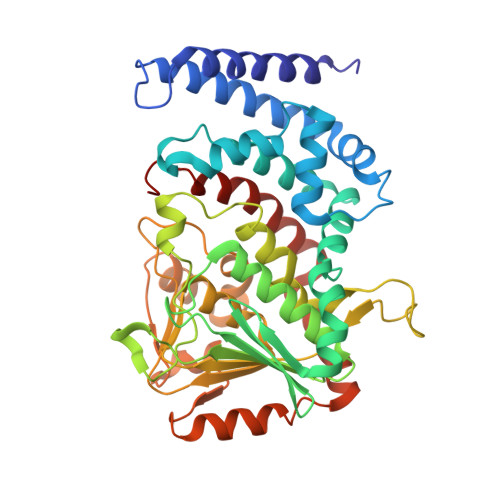Substrate Recognition and Catalysis by the Cofactor-Independent Dioxygenase DpgC.
Fielding, E.N., Widboom, P.F., Bruner, S.D.(2007) Biochemistry 46: 13994-14000
- PubMed: 18004875
- DOI: https://doi.org/10.1021/bi701148b
- Primary Citation of Related Structures:
2PG8 - PubMed Abstract:
The enzyme DpgC belongs to a small class of oxygenases not dependent on accessory cofactors for activity. DpgC is in the biosynthetic pathway for the nonproteinogenic amino acid 3,5-dihydroxyphenylglycine in actinomycetes bacteria responsible for the production of the vancomycin/teicoplanin family of antibiotic natural products. The X-ray structure of DpgC [Widboom, P. W., Fielding, E. N., Liu, Y., and Bruner, S. D. (2007) Nature 447, 342-345] confirmed the absence of cofactors and defined a novel hydrophobic dioxygen binding pocket adjacent to a bound substrate analogue. In this paper, the role specific amino acids play in substrate recognition and catalysis is examined through biochemical and structural characterization of site-specific enzyme mutations and alternate substrates. The results establish the importance of three amino acids, Arg254, Glu299, and Glu189, in the chemistry of DpgC. Arg254 and Glu189 join to form a specific contact with one of the phenolic hydroxyls of the substrate, and this interaction plays a key role in both substrate recognition and catalysis. The X-ray crystal structure of Arg254Lys was determined to address the role this residue plays in the chemistry. In addition, characterization of alternate substrate analogues demonstrates the presence and position of phenol groups are necessary for both enzyme recognition and downstream oxidation chemistry. Overall, this work defines the mechanism of substrate recognition and specificity by the cofactor-independent dioxygenase DpgC.
- Department of Chemistry, Merkert Chemistry Center, Boston College, Chestnut Hill, Massachusetts 02467, USA.
Organizational Affiliation:


















